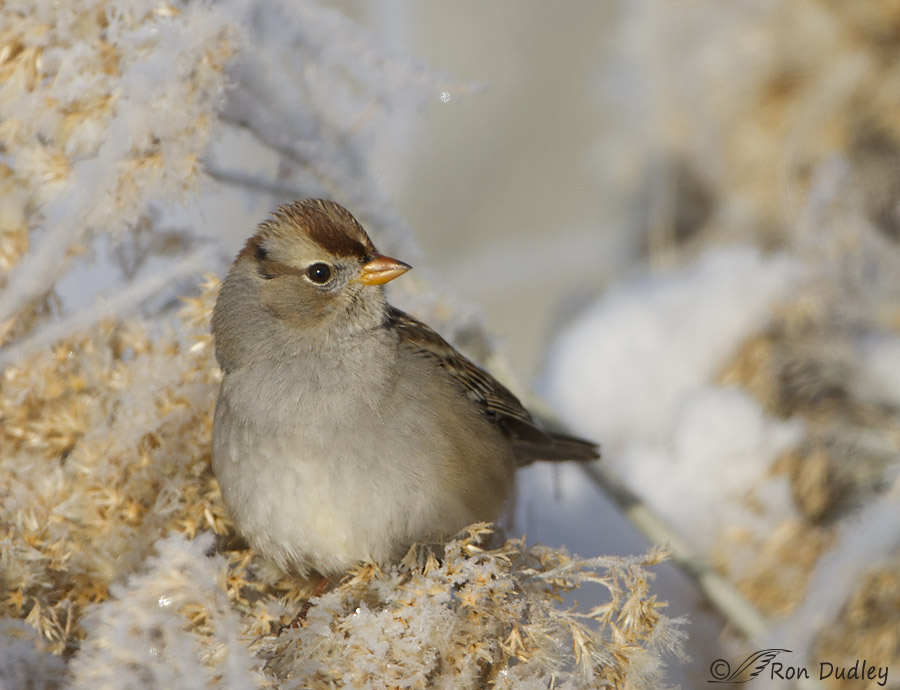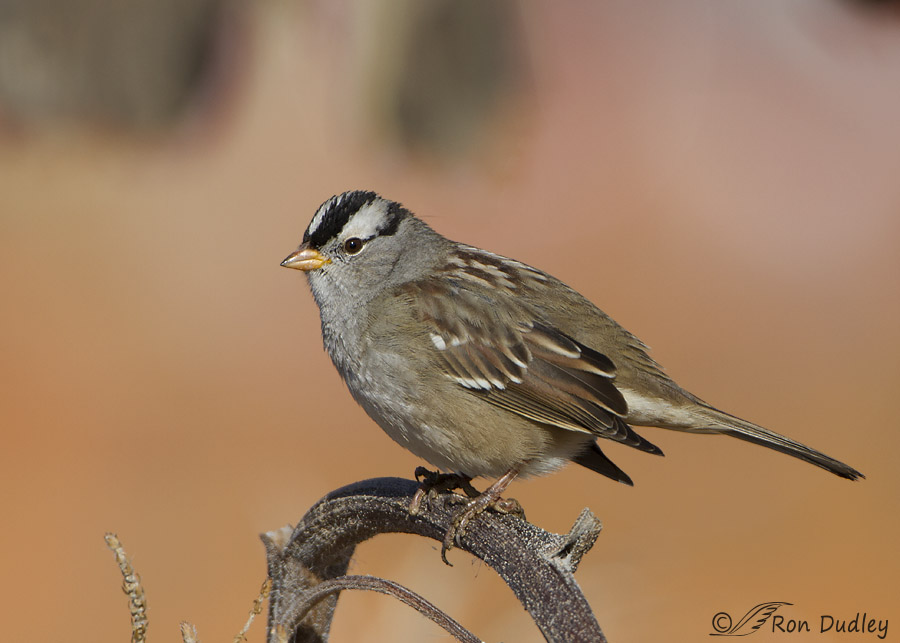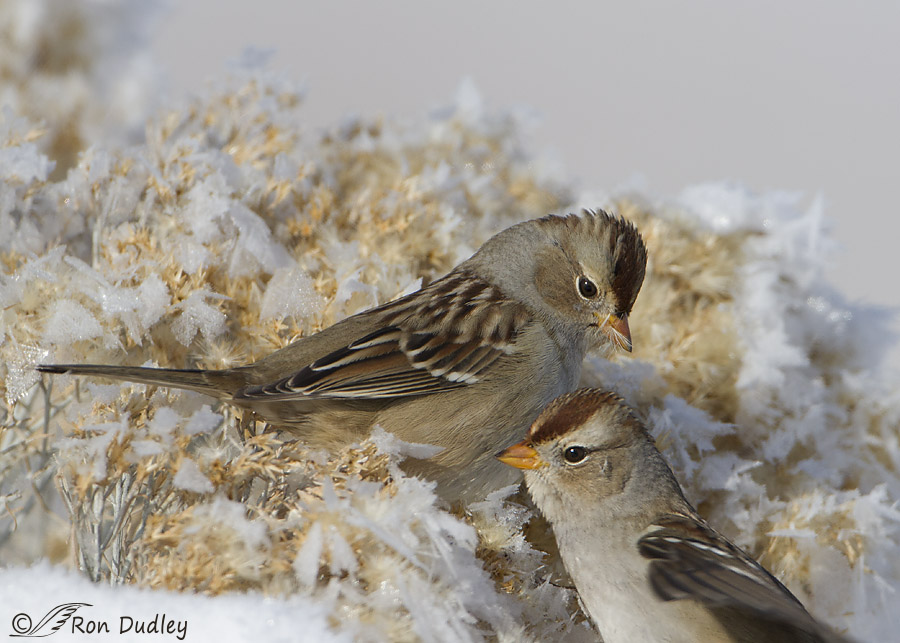Over the years I’ve noticed something perplexing (to me at least) about the apparent relative numbers of immature and adult White-crowned Sparrows.

1/2500, f/6.3, ISO 500, Canon 7D, Canon EF500mm f/4L IS USM +1.4 tc, not baited, set up or called in
Immature (first winter) birds are most easily identified by their brown and buffy head stripes which are in sharp contrast to the…

1/1800, f/6.3, ISO 500, Canon 7D, Canon EF500mm f/4L IS USM +1.4 tc, not baited, set up or called in
black and white head stripes of the adult.

1/2500, f/7.1, ISO 500, Canon 7D, Canon EF500mm f/4L IS USM +1.4 tc, not baited, set up or called in
Here’s another look at two juveniles. So, telling the difference in the field between adult and immature birds in winter is easy.
For years I’ve been struck by the fact that I see many, many more young birds than adults. It happened again yesterday morning on Antelope Island. I’d estimate that I saw about 150 White-crowned Sparrows and only one of them was an adult (that I noticed). I’m curious as to why.
I believe that young birds tend to flock separately from adults but that still doesn’t explain why I see so few adults. I know that many of my readers are more versed in the ways of birds than I am so I’d appreciate any insight anyone might have. The answer is likely simple and obvious but it has yet to appear to this sometimes dense bird photographer.
Ron
Note: I couldn’t resist including the following unrelated but interesting event regarding a White-crowned Sparrow. The species is normally found only in North America but in 2008 one lone bird wandered 3000 miles off course and ended up in jolly old England where it created quite a stir. The Brits are crazy about their birds so when this unexpected migrant landed in the little village of Cley Next The Sea, Norfolk more than 4000 birders (twitchers) showed up to watch its every move. To honor the bird and the event the villagers (with the consent of the Church of England) installed a painting of the bird into one of the stained glass windows of 600 year old St. Margaret’s Church. That sparrow is now referred to as a “bird of pray”.
More information and photos here if you have the interest.


My internet connection could charitably be described as offal today so I am late to the party. And grateful that, being more stubborn than stains, I persevered.
Love the bird of prey, and am fascinated by the disparity in numbers between the adults and the juveniles. I do hope you get an answer to share with us.
Terrific photographs! It’s interesting to see the slight geographic variations of the White-crowned Sparrow.
Not sure why your observations show so many immature versus adult birds. Is this mostly in the fall/winter? If so, it’s possible you’re seeing a lot of first year birds which have migrated from further north and perhaps there are similar numbers of adults in a different location. I hope someone knows the answer ’cause now it’s gonna bother me all year!
“Is this mostly in the fall/winter?”
Yes, it is, Wally. That’s when I see the most of this species. Perhaps you’re right about the potential migration explanation.
Interesting observation about the juvenile:adult ratio. Out here is is more normal; there are of course more juveniles than adults in late summer and fall, before nature thins them out. (In mild climates, they renest and can raise up to 4 broods a year!) But that certainly does not explain a 100:1 ratio, so something else is happening there. Perhaps the adults migrate, perhaps only locally, while the young stay in the area they were raised; that happens with some other species.
Interesting possibility, Tim. I just don’t know and research hasn’t yet provided an answer.
Might be interesting to record the numbers of adults and juveniles, following a survey protocol, in summer and winter; see how the absolute numbers change. Are there more juveniles in winter, or less adults? Could tell you something about migration.
I was watching the birds at the end of the first-day hike we led yesterday and I have concluded that I was mostly looking at a lot of juvenile White-crowned Sparrows (didn’t see the black/white contrast). The only bird that hung around long enough for a good ID was a Ruby-crowned Kinglet. Your photos here are beautiful. I especially like the last one.
So you may be seeing a “mix” similar to what I’m seeing, Susan. Interesting…
I have definitely seen adults around, but most of the time the birds move too fast for my old eyes to focus on them well enough to identify. I can do 65-80 mph botany, but unfortunately I don’t have that skill with birds… 🙂
“I can do 65-80 mph botany”
Loved that line, Susan.
Great shots and interesting questions!
Charlotte
Thanks, Charlotte.
Hi Ron, I thought you would like to hear that here on Long Island, right now (and every day summer and winter in mornings and afternoons) I see the same amount of adults and young. I have noticed that a few adults are looking for seed without young very late afternoons. Right now they are eating deck seeds on the deck and with 4 very large blue jays and two squirrels. Your pictures captured their gentleness that I see and many others do not. Enjoyed the Sparrow pics and the “Bird of Pray” story. Thank you!
Thanks for the report, Dianne. Interesting that you’re not seeing the same disparity that I am.
The third of these shots would make a lovely holiday card. I really like that one. 😀 And I enjoyed the “bird of pray” tale. 😀
The holiday card is an idea I’ll have to keep in mind, Arwen. Thank you.
I have a few different species of sparrows that live and hang out in my yard. I too have noticed the juveniles fly as a group almost always. I see the adults only every once in a while. I enjoyed the story about the lone sparrow crossing over to England. Isn’t that where all the sparrows originated from. Accidentally brought over here on ships from England? My sparrows had so many babies over the summer, seems that’s all I see. Of course the sparrows keep away Eastern Blue Birds. So I haven’t seen any Blue Birds in about a year and a half. Miss the Blue.
Ellen – The species brought over from England is the “House Sparrow” or English sparrow, more accurately an Eurasian Weaver-finch (it isn’t even really a sparrow!). It is also the one that displaces Eastern Bluebirds. The story goes that it was brought over, not by accident, but as a deliberate effort to introduce all the birds mentioned in Shakespeare’s works…
There are, however, many native sparrows in North America.
Thanks Ron. I know I have lots of sparrows and a few different species. They take over everything especially by Blue Bird boxes.
Thanks for the info, Tim. Ellen, I agree with what Tim has said here.
Love the “Birds of Pray” story … and the photos.
Thank you, Dave. Hope all is well in Florida and that you had a sane but fun New Years Eve.